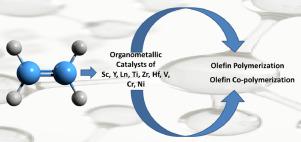Journal of Organometallic Chemistry ( IF 2.1 ) Pub Date : 2021-08-29 , DOI: 10.1016/j.jorganchem.2021.122066 Shubham Kumar 1 , Bharatkumar Z Dholakiya 1 , Ritambhara Jangir 1

|
The chemistry of catalytic polymerization of ethylene and propylene employing titanium complexes and aluminum-alkyls as co-catalysts is well known since last 50 years. Thorough studies show that invention of homogeneous organometallic complexes as catalysts such as metallocenes and other transition metal complexes with methylaluminoxane (MAO) as co-catalyst for the polymerization of olefins has achieved a lot of interest in this area as compared to the well-known and conventional heterogeneous catalysts i.e. Ziegler–Natta and Phillips catalyst. The possibilities of controlling the polymer composition, microstructure, tacticity, stereoregularity and special properties with high precision are found to be high in homogeneous catalysts. Availability of single active accessible site on metallocene catalysts in contrast to their classical equivalents is responsible for improved catalytic polymerization. Furthermore, these single-site catalysts, such as half titanocenes/MAO, zirconocenes, and other single-site catalysts, can control important parameters like co-monomer distribution, molecular weight, molecular weight distribution, molecular architecture, stereo-specificity, degree of linearity, polymer branching etc. The purity in products found less when Ziegler–Natta catalysts were used. This review summarises and compares the recent advances in the polymerization of various olefins (especially ethylene or α-olefins) using various organometallic catalysts consist of rare-earth elements and lanthanides, group 4 metals, and other transition metals (V,Cr and Ni). At the end the review discusses modulation of catalytic activity to control polymerization reactions and concludes the study with future challenges in the area.
中文翻译:

有机金属配合物在烯烃聚合中的作用:综述报告
自过去 50 年来,使用钛络合物和烷基铝作为助催化剂的乙烯和丙烯的催化聚合化学是众所周知的。深入的研究表明,与众所周知的、以甲基铝氧烷 (MAO) 为助催化剂的金属茂和其他过渡金属配合物作为催化剂的均相有机金属配合物的发明在该领域引起了很大的兴趣。传统的多相催化剂,即齐格勒-纳塔和菲利普斯催化剂。在均相催化剂中发现以高精度控制聚合物组成、微观结构、立构规整度、立构规整性和特殊性能的可能性很高。与其经典等效物相比,金属茂催化剂上单一活性可及位点的可用性是改进催化聚合的原因。此外,这些单中心催化剂,如半二茂钛/MAO、二茂锆和其他单中心催化剂,可以控制重要参数,如共聚单体分布、分子量、分子量分布、分子结构、立体特异性、程度线性、聚合物支化等. 当使用齐格勒-纳塔催化剂时,发现产品纯度较低。本综述总结并比较了使用由稀土元素和镧系元素、第 4 族金属和其他过渡金属(V、Cr 和 Ni)组成的各种有机金属催化剂聚合各种烯烃(尤其是乙烯或 α-烯烃)的最新进展. 最后,综述讨论了调节催化活性以控制聚合反应,并总结了该领域未来挑战的研究。











































 京公网安备 11010802027423号
京公网安备 11010802027423号